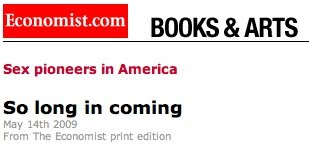The Economist: "If there is a moral to this tale, it is perhaps that the human heart remains as much of a mystery as the sex organs once used to be."

So long in coming
May 14th 2009
From The Economist print edition
Masters of Sex: The Life and Times of William Masters and Virginia Johnson, the Couple Who Taught America How to Love
By Thomas Maier
Basic Books; 384 pages; $27.50 and £15.99
Buy it at
Amazon.com
Amazon.co.uk
WHEN William Masters was an associate professor of obstetrics at Washington University in the early 1950s, he wanted to see the library’s one textbook on human sexual physiology. No dice. The book was regarded as possibly pornographic, and thus reserved for full professors. Actually, he would not have learnt much even if the librarians had been persuaded to slip him the volume in a brown paper bag. In those days people’s sex organs were pretty much terra incognita, as a new biography of Masters and his research partner, Virginia Johnson, vividly explains.
Human sexual behaviour had been studied, since the late 1940s, by Alfred Kinsey, another American researcher. But Kinsey’s work was sociological, not medical. He reported what people said they did to themselves and to each other. He did not investigate how any of it actually worked. The goings-on in the Masters and Johnson laboratory, by contrast, were audacious, rigorous and weird. Female volunteers masturbated with “Ulysses”, a Plexiglass motorised dildo containing a camera, while wearing paper bags over their heads to preserve modesty. Hundreds of wired-up couples copulated under conditions of intense scrutiny. Over 12,000 orgasms were logged in the research for Masters and Johnson’s first book, “Human Sexual Response”, which was published in 1966. “Why”, asked a laudatory editorial in the Journal of the American Medical Association, without a trace of irony, “was this study so long in coming?”
The researches of Masters and Johnson demolished Freudian ideas of female sexuality: there was nothing inferior about a clitorally induced orgasm. And women, unlike men, were naturally multi-orgasmic—given the right techniques. After their first book, Masters’s and Johnson’s work began to focus on treatments for sexual dysfunction. Here, as Masters acknowledged, it was the medically unqualified Ms Johnson who contributed most. Today’s talking and touching therapies for couple’s sexual problems are largely based on her ideas, just as the development of Viagra and its ilk owe much to the physiological research of Masters.
Early on in their partnership, Masters (who was married) persuaded Ms Johnson (a twice-divorced mother of two) to sleep with him. He argued that this would help to avoid the worse sin of becoming sexually involved with their patients. She agreed, because she wanted to keep her job. By 1970, the tables had turned and it was Masters who feared an end to their professional partnership. Ms Johnson was on the brink of marrying a rich patron of their institute, so Masters suddenly divorced his wife, in an apparent bid to keep Ms Johnson from leaving. Ms Johnson married Masters the next year. It is not clear why she did so, as they were not in love; she said she did not know why she married her first husband, either. At the end of 1992, Masters suddenly decided it was time to change partners again, divorced Ms Johnson, and then married a long-lost sweetheart of his youth, whom he believed (mistakenly, as it turned out) had jilted him a half-century earlier. If there is a moral to this tale, it is perhaps that the human heart remains as much of a mystery as the sex organs once used to be.
Masters of Sex: The Life and Times of William Masters and Virginia Johnson, the Couple Who Taught America How to Love.
By Thomas Maier.
Basic Books; 384 pages; $27.50 and £15.99
